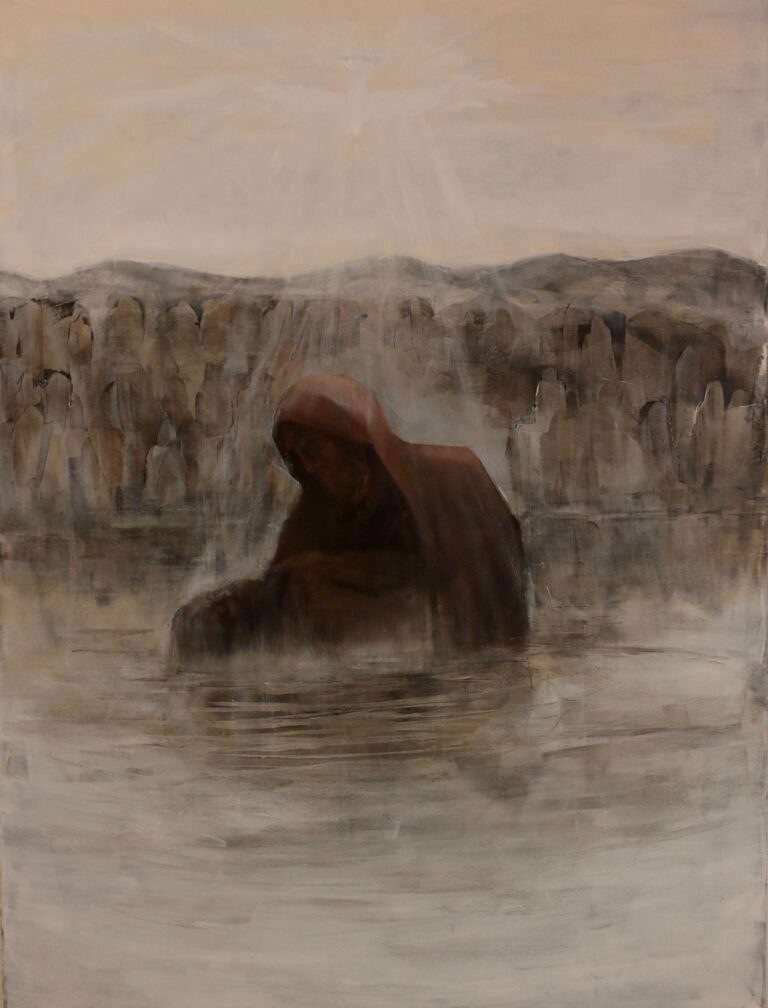Just sandals and a walking stick
Note from Sister Julia: A version of the following text was written for my coursework in my Introduction to New Testament course at Catholic Theological Union where I am a part-time student. The assignment was to write a Biblical commentary on a particular Gospel passage. The passage I selected was Mark 6: 7-13, which was the Gospel for this past Sunday.
 Jesus summoned the Twelve and began to send them out two by two
Jesus summoned the Twelve and began to send them out two by two
and gave them authority over unclean spirits.
He instructed them to take nothing for the journey
but a walking stick—
no food, no sack, no money in their belts.
They were, however, to wear sandals
but not a second tunic.
He said to them,
“Wherever you enter a house, stay there until you leave.
Whatever place does not welcome you or listen to you,
leave there and shake the dust off your feet
in testimony against them.”
So they went off and preached repentance.
The Twelve drove out many demons,
and they anointed with oil many who were sick and cured them.
Jesus gave a particular Mission to the Twelve from the Gospel of Mark. And, it is a very interesting story when you are aware of the historical context. In the time of Jesus, there was another group of countercultural preachers who belonged to what was called the Cynic movement. They were founded by Diogenes of Sinope in fourth century Greece and had spread throughout the Mediterranean world, including Palestine. They carried a staff to show that they were homeless and a knapsack to show that they were self-sufficient. They were urban and individual. What Jesus establishes with his sending of the Twelve is a very different movement, as his missionaries were rural and communal and did not carry a knapsack (nor a staff, in Luke and Matthew). This showed their solidarity with and dependence on those to whom they preached. [1]
Like the Twelve, we are called to embrace God’s mission and serve. We must move out and go to be with the other to serve and share the good news. But we don’t arrive as heroes or messiahs, we come to companion and be a guest. We are equal with those who we help, as we unite with their experience of daily life and receive their hospitality. As we give messages of hope and healing, we receive. This is real solidarity and interdependency. It is a radical way of loving ones neighbor, for this “walking with” will not make us into the rich, famous or accomplished.
In order to really live the Gospel in this way of mutuality we may need to change our life around. We may need to change our mind about what it means to help and to serve in the name of God. We may need to make changes in our life in order to be present to others in the ways that God needs us.
In order to do this with integrity and love, it is necessary for us to pause and assess the circumstances in which we find ourselves. I offer a few simple reflection questions to guide us as we seek to implement Jesus’ mission into our modern times.
Question 1.) Who are you with? The Mission of the Twelve begins with Jesus summoning his friends and then sending them out as pairs. Christ summons each of us and wants us to remember that we are not alone. For the disciples of Jesus in the first century, it could have been dangerous to travel alone. Plus, people would have been less likely to take them seriously and welcome them if they were solo travelers. For us who are also called to build the reign of God, it is unnecessary and foolish for us to try to be alone in doing good for God. We are a communal people. We belong to a Trinitarian God of relationship. We need each other. Let us lean on others for support as we do the work of God. Let us support and unite with others while we do that which God calls us.
Question 2.) What does God need us to bring? The instructions that Jesus gives the Twelve is that they are to “take nothing for the journey.” (Although they could have a staff, a second tunic and a walking stick.) I am reminded of the time when I was a Jesuit Volunteer and flew to California to work with homeless youth for an entire year. As I was preparing for my missionary experience, a letter from the Jesuit Volunteer Corps program director arrived and challenged me. The letter quoted this passage from Mark and reminded me that I would be arriving to a fully furnished house. I was asked to pack lightly and bring little with me so I could learn to live simply and live in solidarity with the poor. Packing was a real struggle because it helped me to recognize my attachments. Somehow I sensed that the less I went with, the more open I would be to receiving whatever God had in store for me. I knew I could trust the circumstances and I could trust God. We need to bring trust in God.
Question 3.) What does God need us to leave behind? When I was packing for my year of service it felt very freeing to realize that I could leave a lot of my possessions behind and start fresh in a new city. It became clear that I was bringing a lot of excitement and eagerness for my adventure. It also became clear that it would not be helpful for me to be guided by fear, but by love. Just as The Twelve, I needed to leave behind any attachments that could get in the way of serving God, especially any lingering attachments to fear. The Twelve needed to leave behind anything that would prevent them from being open to those who they would meet, anything (such as a purse and money) that would not show them to be an equal. God needs us to leave behind fear and other attachments that prevent us from being open to others.
When Jesus sent the Twelve on a mission, he was establishing a movement to live out his mission. In our day, we are also sent to serve. Like the Twelve, as we go on our journeys and do acts of love, we must bring hearts full of trust in God, leave fear behind and be ready to love all we meet as equals. When we move in this way, we will build relationships in solidarity and interdependency. We will build the Kingdom of God! May God bless us as we go. Amen!
[1] John Dominic Crossan, The Essential Jesus: Original Sayings and Earliest Images, (San Francisco: Harper Collins Publishers, 1994), 148.






Thanks for this. It’s a sharp call for me.